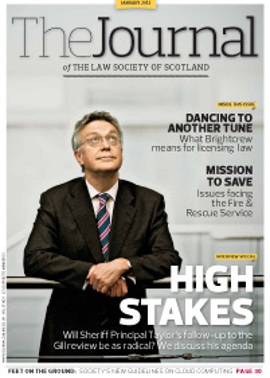A matter of life and death

Two recent fatal accident inquiries have examined the part played by the Fire & Rescue Service (“FRS”), in undertaking rescues. First, the Inquiry into the deaths of Craig Currie, William Carty, Stephen Carty, and Thomas Douglas [2011] FAI 43 (10 October 2011) examined, in part, the provision of rescue equipment and the emergency response to the report of four missing anglers on Loch Awe in 2009. Secondly, the determination in the Inquiry into the death of Allison Hume [2011] FAI 51 (16 November 2011) considered the approach taken by the FRS in effecting a person rescue in Ayrshire. Ultimately and tragically, that rescue proved to be unsuccessful.
Following the Hume determination, the Government has ordered an additional review, to be undertaken by the Scottish Fire Service Inspectorate. The principal purposes of that review include to evaluate the practices now employed by Strathclyde FRS and to consider the implications for all eight Scottish FRSs. Given the Government’s recent decision to amalgamate the Scottish fire services, the outcome of this review could have wide ranging consequences.
A duty to rescue?
Currently, the responsibility for undertaking rescues is unclear.
There are a number of organisations which undertake rescues in and around the United Kingdom, though many do so on a voluntary basis. While the police have a duty “to protect life and property” (Police (Scotland) Act 1967, s 17(1)(a)(iii)), only the Fire & Rescue Service has a statutory duty to effect rescues.
In 2005, the former individual fire brigades in Scotland were renamed Fire & Rescue Services. This reflects the fact that the Fire (Scotland) Act 2005 obliged such fire brigades to undertake rescues for the first time. Prior to then, the fire brigade had a statutory duty to attend fires only.
Perhaps surprisingly, the scope of the “rescue” remit is limited – under s 10 – to FRSs making “provision for the purpose of– (a) rescuing persons in the event of road traffic accidents”. This is the only mandatory obligation to undertake rescues under the primary legislation. However, under s 11, the Scottish ministers may make an “additional function order” on a fire authority. This they have done, through the Fire (Additional Function) (Scotland) Order 2005 (SSI 2005/342), which obligates FRSs to rescue people from: landslides or the collapse of buildings, tunnels or other structures (article 4); serious flooding (article 5); and serious transport incidents (article 6). In addition, under s 13 of the Act a FRS “may take any action it considers appropriate– (a) in response to an event or situation that causes or is likely to cause– (i) a person to die, be injured or become ill”.
The statutory obligation on FRSs to rescue people is therefore confined to a few narrowly defined incidents. However, the discretionary powers afforded to FRSs under ss 13 and 14 of the 2005 Act (the latter section allowing FRSs to provide manpower and equipment to others) potentially blur the duty to effect rescue even further.
In the Hume determination, Sheriff Leslie examined the above statutory framework. He considered that the term “other structure” (article 4 of the SI) included a mine shaft and by doing so, found that the FRS was obliged to undertake a rescue. The determination was ultimately critical of the systems and procedures employed by the FRS under the statutory regime. At the same time, the determination rehearses previous authorities about the purpose of an FAI. The purpose is not to find fault.
The liability conundrum
So where does that leave the liability of FRSs in respect of rescues? In respect of liability to third parties, acts or omissions of a FRS in the proper exercise of its powers do not create a civil action (see Stair Memorial Encyclopaedia, Fire Reissue). This concept finds its roots in the case Dorset Yacht Co Ltd v Home Office [1970] AC 1004: “in the case of a power, liability cannot exist unless the act complained of lies outside the ambit of the power”. This poses an interesting jurisprudential conundrum: if the remit of the FRS does not include certain types of rescue, does this expose a FRS in the event that it responds to and engages in a rescue?
For example, if on receipt of a 999 call the FRS mobilises to the report of an animal rescue (something which, to the best of my knowledge is, not covered by primary or secondary legislation, but something which the FRS deals with), can it be liable for acts or omissions? In what circumstances does the FRS accept (or indeed, decline) the call to help? Is it when it arrives at an incident? Does it need to formally accept the responsibility of undertaking the rescue? And if, under s 13, say, it chooses to act, is it acting within its “power”, as contemplated by the Dorset Yacht principle? These are questions which the Fire Inspectorate Review will hopefully consider and answer.
There is, however, another aspect of liability that requires to be considered: an employer’s liability to its employees under health and safety legislation. Health and safety is a big issue in the Fire Service. Whereas in an office it is relatively easy to “risk assess” hazards, it is much more difficult to do so at an emergency incident – where, by its very nature, somebody has already succumbed to danger. Just recently at the Glasgow Co-operative building fire, there were reports of a firefighter being stranded in smoke at the top of an aerial platform that broke down 80 feet above the ground. No doubt the ramifications of that will be considered under health and safety grounds.
The obvious difficulty is achieving the correct balance. It is clear from the Hume determination that the officers who commanded the rescue were concerned (whether justifiably or otherwise) about health and safety issues affecting their crews. While the FRS cannot ignore its obligations to employees, there is always likely to be a tension between the organisation’s concern for health and safety (and the possibility of being sued), and the frustrations of firefighters to undertake the role that they signed up for. Such a tension is clear in the Hume determination. In my view, the issue of balancing operational health and safety requires to be addressed in the Fire Inspectorate Review.
In this issue
- Reading for pleasure
- IP: the call of the south
- IP: home advantage
- Forcing: the issues
- Construction disputes: what of mediation?
- The key to effective trainee development
- Opinion
- Book reviews
- Council profile
- President's column
- Register reborn
- Justice at stake
- A matter of life and death
- The future is Brightcrew?
- Safe keeping
- Always something new
- Control switches
- Hard cases
- Whose law rules?
- Service complaint figures
- Scottish Solicitors' Discipline Tribunal
- Mora no more?
- Head in the cloud - feet on the ground
- Crown offers safer mail
- Law reform roundup
- CPD competition
- Don't be tempted!
- Ask Ash
- Preparing for spring






